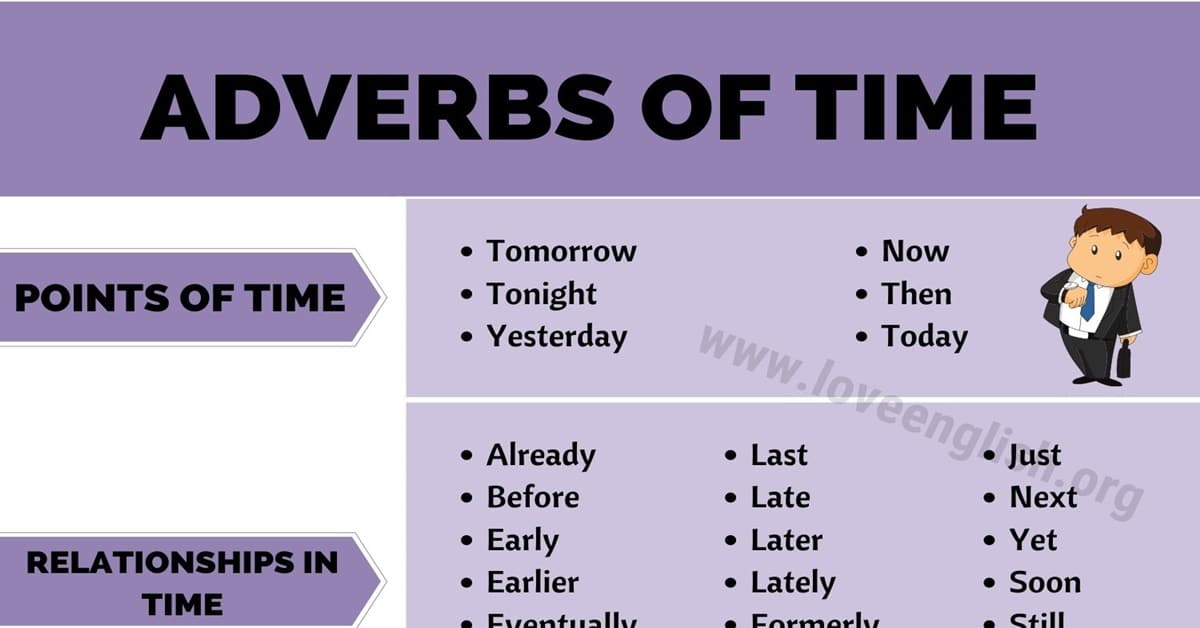Example Of Adverb Of Time - Types of Adverbs, Definition and Examples - English ... / Review adverbs expressing time, aspect, duration, and frequency, and their compatibility with each tense.
Example Of Adverb Of Time - Types of Adverbs, Definition and Examples - English ... / Review adverbs expressing time, aspect, duration, and frequency, and their compatibility with each tense.. The teacher's grammar of english with answers: Today, yesterday, later, now, last year. I was sitting in front of her door all that time. The examples are italicized for easy identification. Time adverbs can tell us about when an action happens, (now, soon, etc.) or how frequently an action happens (usually, always, etc.) adjectives and adverbs easily confused words nouns, pronouns and determiners prepositions and particles words, sentences and clauses using english verbs.
Adverbs of time mainly modify verbs and tell us when something happens. An adverb clause of time shows when something happens. *yellow highlighted words are examples of incorrect usage. However, manner adverbs, frequency adverbs, time adverbs, degree adverbs and place adverbs are the most commonly used. Note that all adverb clauses are subordinate clauses.

Adverbs of time tell us when something happens.
Some other how often adverbs express the exact number of times an action happens and are usually placed at the end of the sentence: However, we can sometimes place adverbs of time at the beginning of the sentence to put an extra emphasis on the time or duration being described. She arrived home three hours later. After already during finally just last later next now recently soon then tomorrow when while and yesterday. An adverb of time is an adverb that describes when the action of a verb is carried out. When it is of particular importance to express the moment. Adverbs of time tell us when something happens. June 3, 2021february 19, 2019 by the english teacher. This article provides plenty of examples. These adverbs can describe how often, how long or when something takes place. Adverbs of time tell us when an action happened. Before, after, as, when, while, until, as soon as, since, no sooner than, as long as etc. Vocabulary for esl learners and teachers.
Adverbs that tell us when are usually placed at the end of the sentence. Before, after, as, when, while, until, as soon as, since, no sooner than, as long as etc. #adverbsoftime #englishgrammar #pardhaighar #banomisaalpakistankiin this video we'll discuss about adverbs of time which tell us when an action happened. I was sitting in front of her door all that time. However, manner adverbs, frequency adverbs, time adverbs, degree adverbs and place adverbs are the most commonly used.

Adverbs of time are those words which tell us about the time of any action that takes place in the past, present or future.in other words, adverbs of time tell speakers tend to use definite adverbs of time when they have details about the precise time of occurrence of any action.
These adverbs can describe how often, how long or when something takes place. I was sitting in front of her door all that time. A course book and reference guide adverbs of time (pg 249) by ron cowan gohar english teacher's notes 3 adverbs of time. The adverbs of time tell us when an action takes time, its duration and frequency. They answer the question when or how often did the action occur? Adverbs of time answer the question when? What is an adverb of time? I'm going to tidy my room tomorrow. Common examples of time adverbs are shown in this study, with example sentences. In order to avoid complexity, if any situation is not common or important, we often need to. He came home before dark. It tells us when an action happened besides how long, how often. Some other how often adverbs express the exact number of times an action happens and are usually placed at the end of the sentence:
* i am reading now. Today, yesterday, later, now, last year. I'm going to tidy my room tomorrow. Adverbial phrase is a group of words showing when, how long or how often something happens. Some other how often adverbs express the exact number of times an action happens and are usually placed at the end of the sentence:
June 3, 2021february 19, 2019 by the english teacher.
Adverbs of time tell us when an action happened, but also for how long, and how often. Specify the timing of an action or activity. An adverb of time is an adverb that describes when the action of a verb is carried out. An adverb clause of time shows when something happens. Adverbs of time are those words which tell us about the time of any action that takes place in the past, present or future.in other words, adverbs of time tell speakers tend to use definite adverbs of time when they have details about the precise time of occurrence of any action. Let's learn more about these types of adverbs and explain them with examples. Adverbs of time tell us when something happens. Adverbs of time are usually placed at the beginning or end of a sentence. 'yet' is an adverb of time which tells us that something hasn't happened, but it's expected to happen. It's used at the end of a sentence, either on its own when. Time adverbs can tell us about when an action happens, (now, soon, etc.) or how frequently an action happens (usually, always, etc.) adjectives and adverbs easily confused words nouns, pronouns and determiners prepositions and particles words, sentences and clauses using english verbs. We usually put them at the end of a sentence, but they can also change position depending on whether the speaker wants to use emphasis. I said i could wait for her as long as she wanted.
Komentar
Posting Komentar